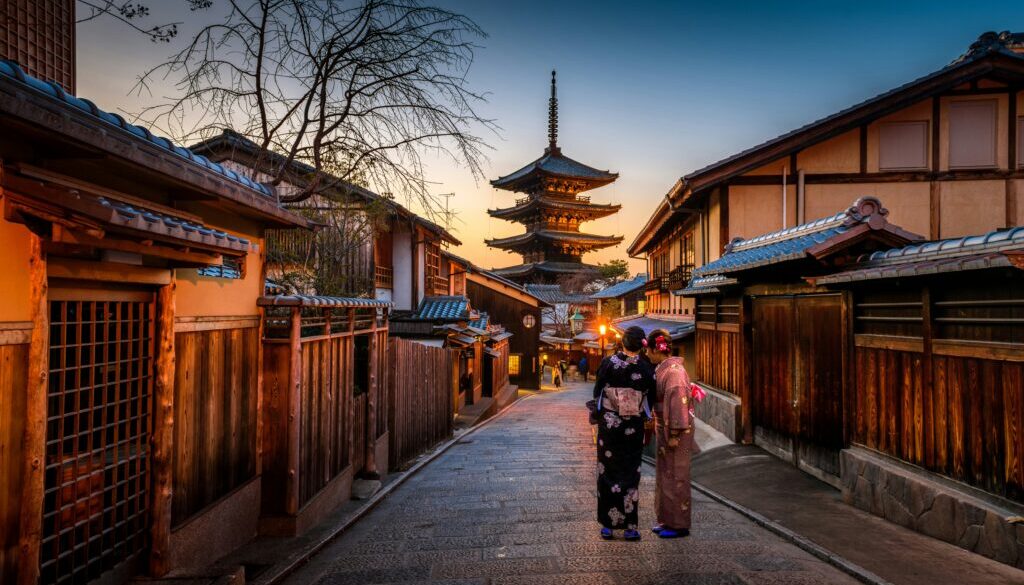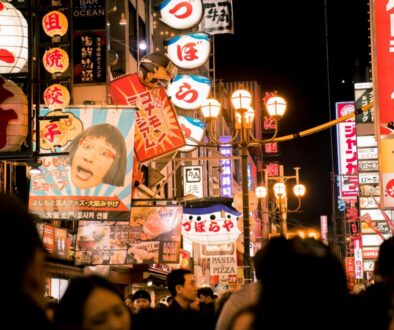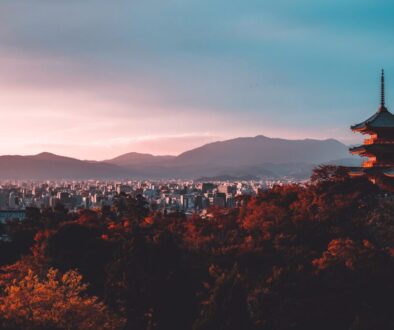Kyoto is one of the world’s great places to experience kaiseki cuisine. But what exactly is kaiseki? It is a multi-course haute cuisine rooted in respect for seasonality, ingredients, presentation, and ritual.
Kaiseki is more than just food. It’s an experience: the sequence of courses, the setting (tatami room, garden view, etc.), the aesthetic of plating, and the hospitality (omotenashi). All this combined makes for a truly elevated and unforgettable experience.
While it’s true that some of the most prestigious kaiseki restaurants in Kyoto can cost upwards of ¥50,000 per person, the good news is this: you don’t need to spend a fortune to experience it.
In this guide, we’ll introduce you to 5 of the best budget-friendly kaiseki restaurants in Kyoto. These places strike the perfect balance between authenticity, atmosphere, and affordability.
Whether you’re a first-time visitor, a foodie on a budget, or simply curious about Japanese haute cuisine, you can savor Kyoto’s culinary heritage without emptying your wallet.
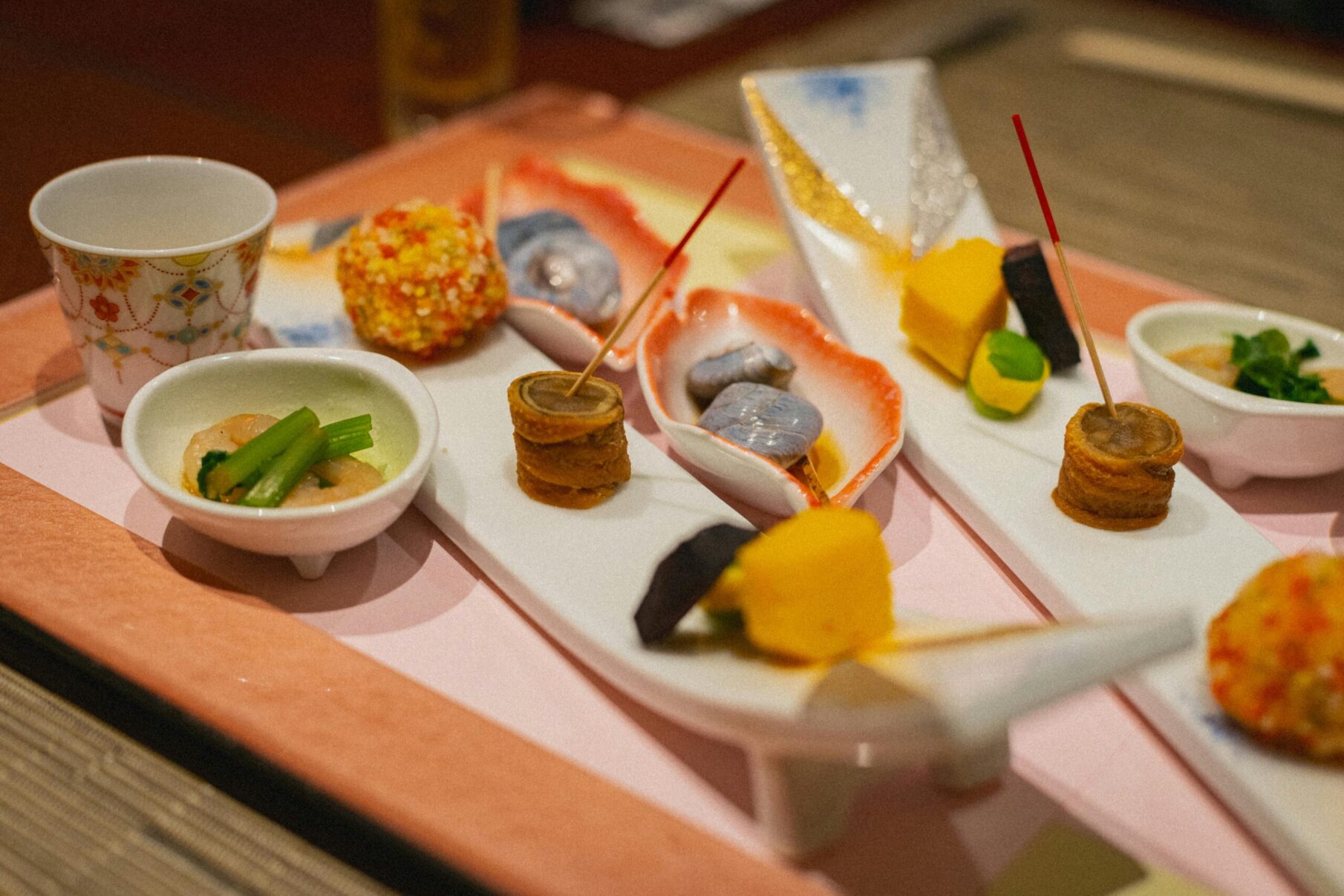
What is Kaiseki?
Kaiseki (懐石料理) is Japan’s most refined form of multi-course dining, often compared to haute cuisine in the West.
Originating in Kyoto, Kaiseki showcases the seasonality of ingredients, artistic presentation, and a balance of taste, texture, and appearance. More than just a meal, it is a cultural journey through Japanese hospitality (omotenashi) and aesthetics.
Once reserved for the nobility and tea ceremonies, kaiseki has evolved into an art form that celebrates seasonality, presentation, and the harmony of flavors. Each dish is prepared with meticulous attention to detail, highlighting the natural flavors of seasonal ingredients. Presentation, plating, and the sequence of courses are as important as taste, creating a dining experience that feels more like an art performance than just a meal.
Key Features of Kaiseki
- Seasonal Ingredients (Shun): Every dish reflects the current season, from spring’s bamboo shoots to autumn’s matsutake mushrooms.
- Artful Presentation: Plates are chosen to complement the food, creating a harmony of color, shape, and design.
- Delicate Balance: Kaiseki emphasizes subtle flavors, ensuring no one element overwhelms the meal.
- Course Flow: Meals usually progress from light dishes (like sashimi) to grilled, simmered, and steamed items, ending with rice and dessert.
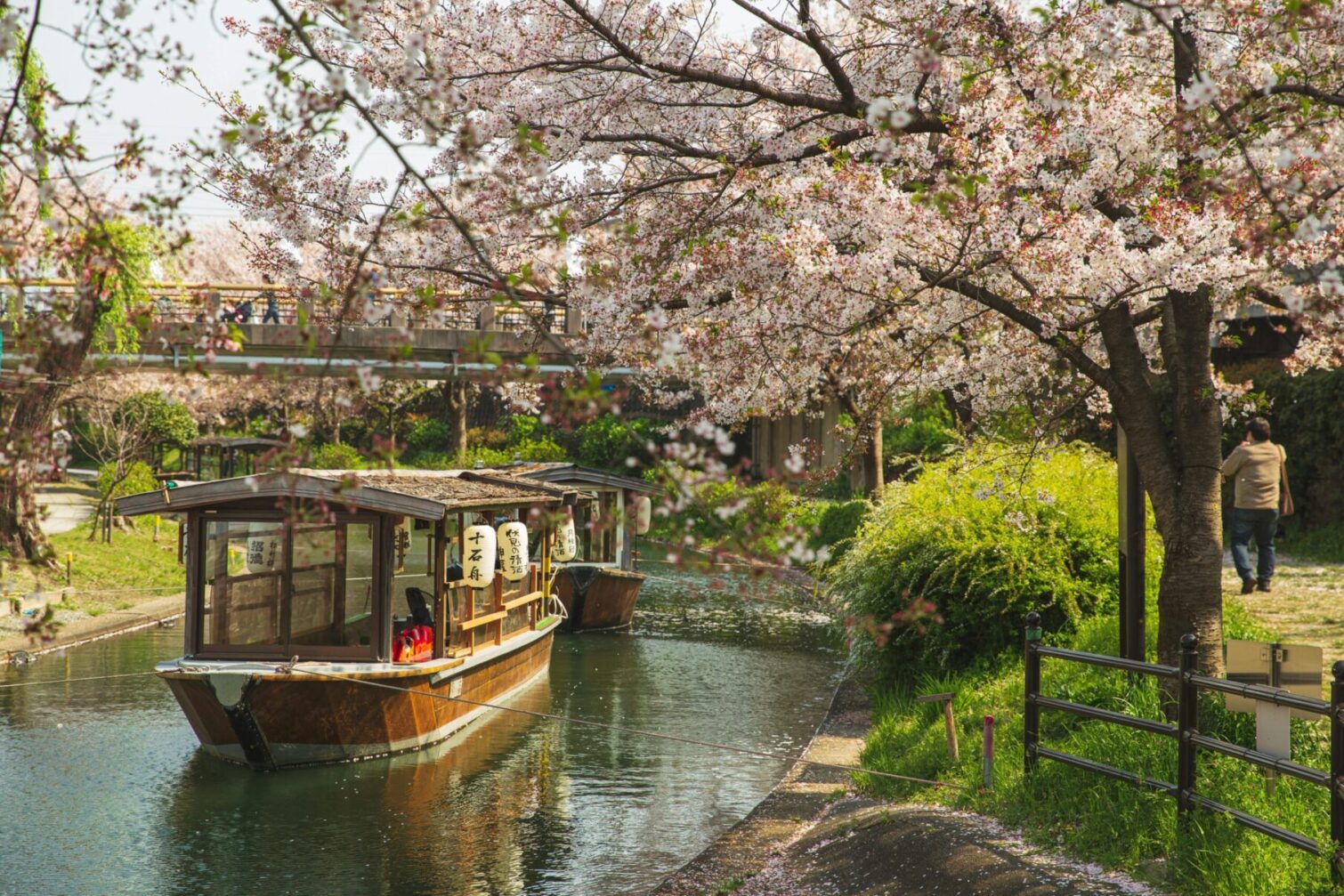
Why is Kaiseki Special in Kyoto?
Kyoto is considered the birthplace of Kaiseki, influenced by Zen Buddhist tea ceremony traditions and the city’s long history as Japan’s cultural capital.
Kyoto’s geography is unique, as it is surrounded by fertile valleys, mountains, and rivers. This provides chefs with an abundance of seasonal produce, freshwater fish, and mountain herbs, all of which shape their seasonal menus. The result is a dining experience that feels both timeless and deeply connected to nature, which are very important aspects of kaiseki.
Many Michelin-starred restaurants and historic ryotei (traditional dining houses) in Kyoto serve kaiseki, making it the best place in Japan to experience this culinary art.
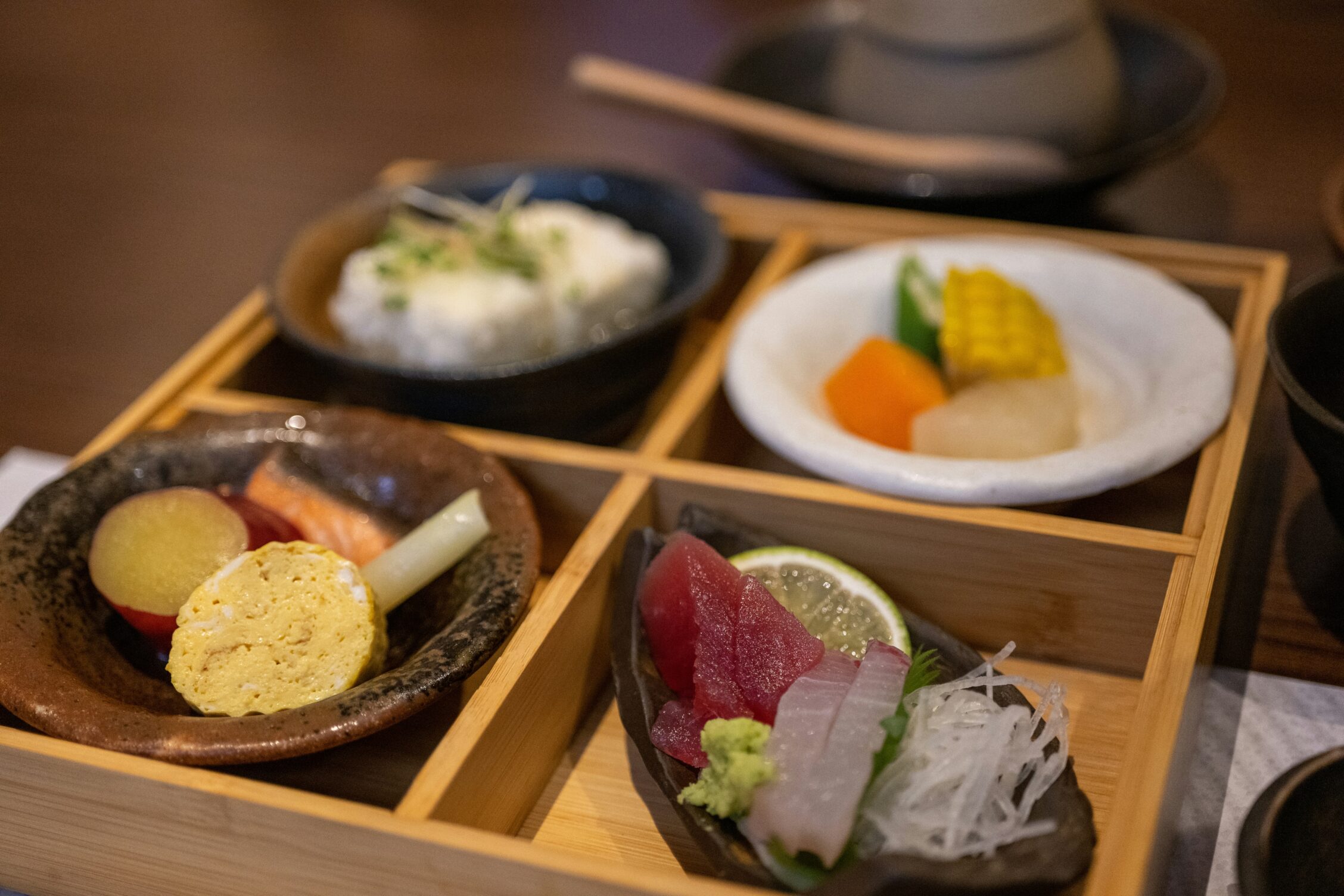
Tips for Choosing & Booking Kaiseki While on a Budget
Before we get into the kaiseki restaurants we recommend, let’s discuss how to choose the best kaiseki restaurant for you, based on your budget, the season, and style.
Depending on what kind of experience you want, here are things to think about:
- Time of Day
Lunch Kaiseki (or small courses) are often more affordable, less formal, and still excellent. Dinner is more elaborate. - Location & Atmosphere
If you want old Kyoto, geisha-district ambience, teahouse-y streets, gardens, pick places in Higashiyama, Gion, Arashiyama. - Menu Seasonality
Try to visit when ingredients are at peak (e.g. autumn mushrooms, winter fish etc.). Many top places only operate with certain courses during certain seasons. - Make Reservations Early
Especially for the high end ones, you’ll often need to book weeks in advance. Some require contact by phone/email ahead. - Book Early: Budget-friendly kaiseki spots are popular and often require reservations, especially on weekends.
- Consider Shojin Ryori: Vegetarian temple cuisine is a unique, affordable alternative to traditional kaiseki.
- Keep an Open Mind: Kaiseki is about subtle flavors, not bold seasonings. Approach it as a cultural experience as much as a meal.
Dress & Etiquette
As these establishments are for fine dining, please make sure to:
- Refrain from wearing casual clothes such as shorts or tank tops.
- Refrain from wearing sports or gym clothes, such as yoga pants or sweatpants.
- Wear socks. Many of these restaurants have you take your shoes off. Sandals are not allowed.
- Refrain from wearing strong perfume or cologne.
If you do not follow these rules, you may be denied entry upon arrival.
Top 5 Budget-Friendly Kaiseki Restaurants in Kyoto
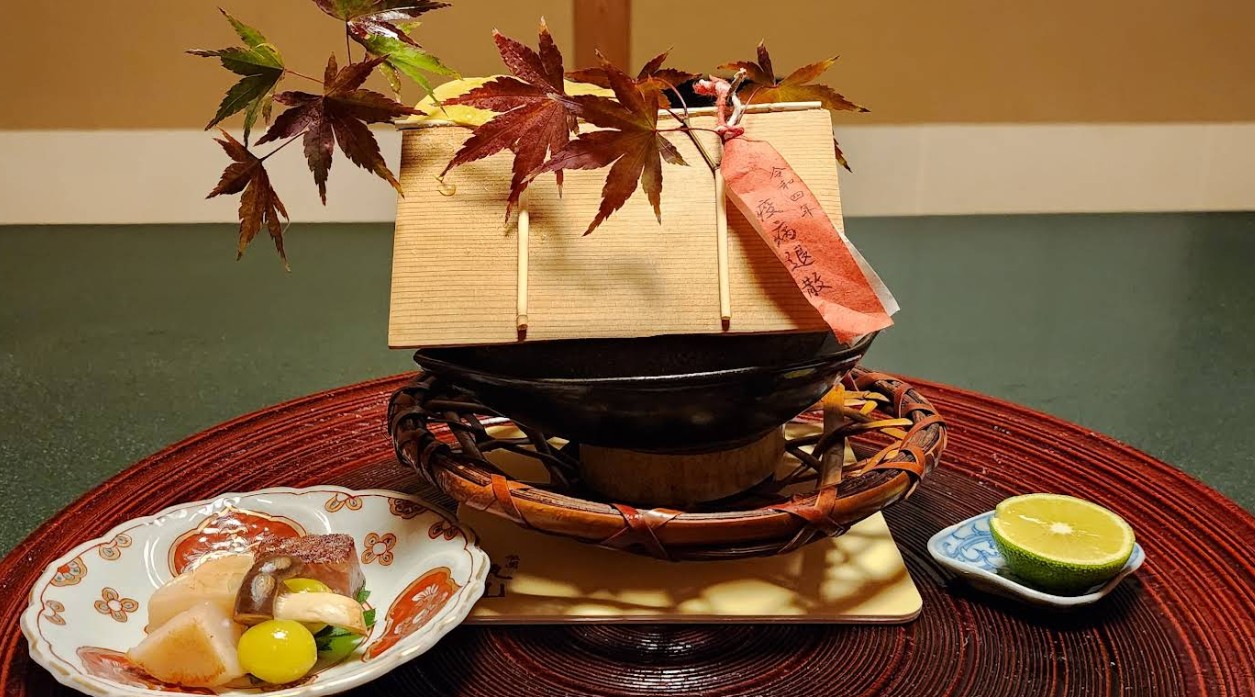
Gion Maruyama (祇園丸山)
Why it’s great: Gion Maruyama is a well-regarded kaiseki restaurant located in the heart of Kyoto’s historic geisha district. Known for its refined yet welcoming atmosphere, it offers a classic kaiseki experience without the intimidating price tag of ultra-high-end establishments like Kitcho. They are also a child-friendly restaurant, as they have a special kaiseki set just for children.
- Cost: Lunch courses start at around ¥18,000, offering excellent value for the quality. Dinner is more expensive (¥30,000+ depending on the season) but still reasonable compared to other top-tier dinner kaiseki courses.
- Atmosphere: Traditional tatami rooms and serene interiors make it ideal for an authentic Kyoto dining experience. This is the best experience if you want to balance budget, traditional atmosphere, and experience.
- Location: Conveniently located in Gion, making it easy to combine with sightseeing at Yasaka Shrine or Hanamikoji Street. You might even see a geisha on your way!
- Reservations: Reservations are highly recommended. Please visit their website and reserve HERE.
Visit Gion Maruyama HERE!
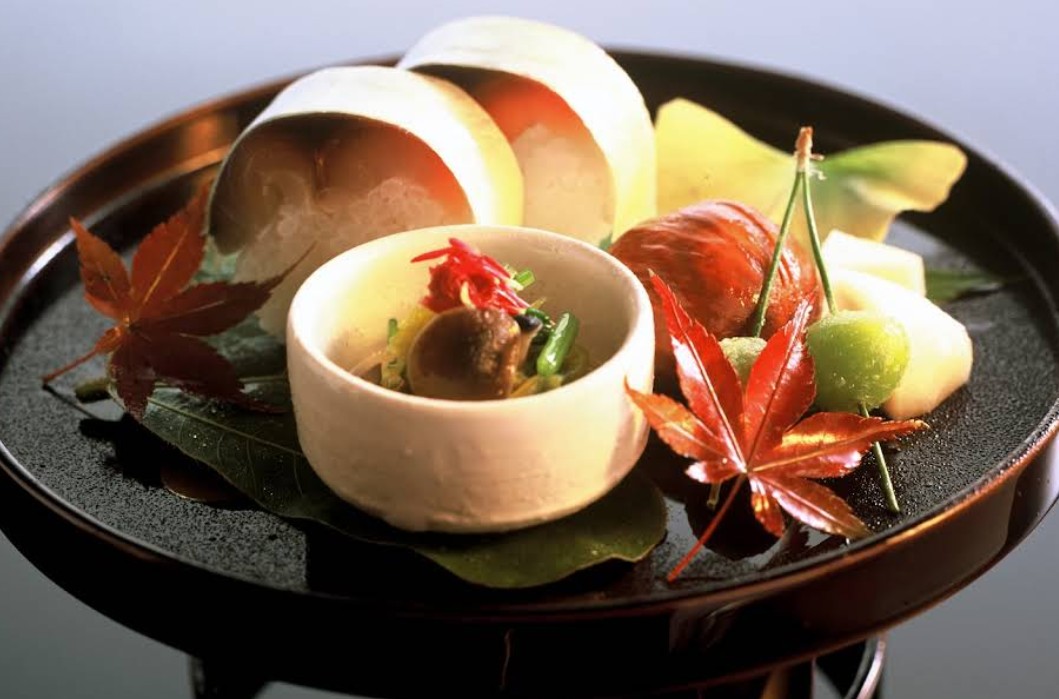
Kinobu (木乃婦)
Why it’s great: Established in the early 20th century, Kinobu is a family-run kaiseki restaurant that blends tradition with a warm, welcoming atmosphere. Unlike the ultra-formal establishments, Kinobu makes fine dining approachable while preserving authenticity. They also offer vegetarian kaiseki in the form of “shojin ryori”, or buddhist monk cuisine.
- Cost: Their traditional kaiseki dinner ranges from ¥17,600~¥34,100 depending on the season. However, if you’re aiming for a lower budget, they do beautiful Kyoto bento box lunches for ¥4,950~¥10,800 depending on the season.
- Atmosphere: A calm, elegant setting with seasonal decor that reflects Kyoto’s rich cultural heritage.
- Location: Centrally located near Shijo, making it convenient for travelers staying in downtown Kyoto.
- Reservations: Reservations are recommended, especially for dinner. Please make a reservation via their phone number listed on their website HERE at the bottom of the site. (Have your hotel receptionist make the call if you would rather not talk on the phone, they would be happy to book for you.)
Visit Kinobu HERE.
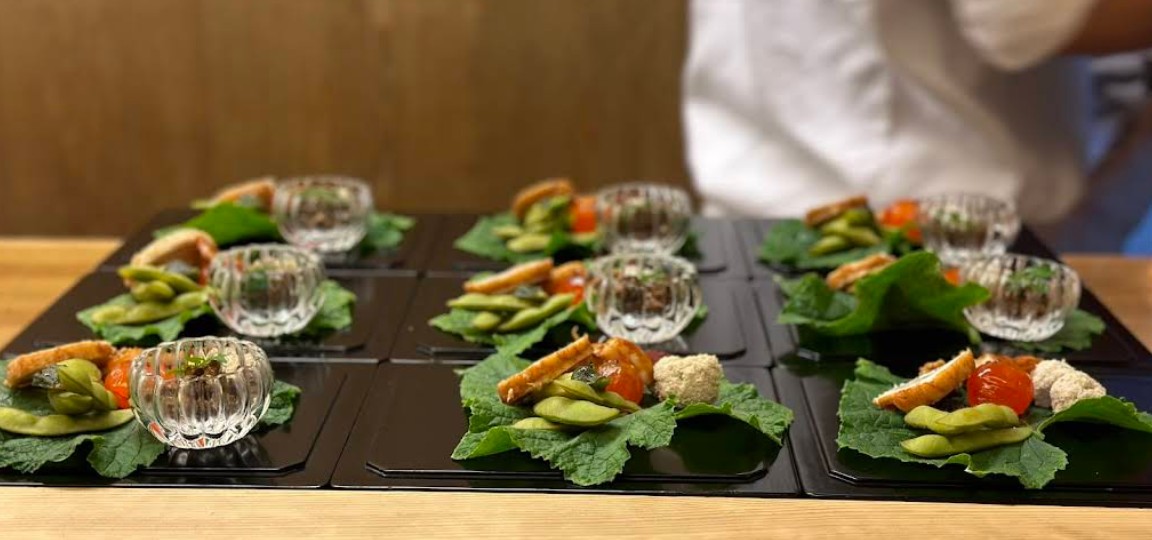
Kikunoi Roan (露庵 菊乃井)
Why it’s great: This is the younger sibling of the world-famous Kikunoi restaurant. While Kikunoi’s main location in Higashiyama is a three-star Michelin restaurant and extremely pricey, Roan Kikunoi offers a more relaxed and affordable way to enjoy the same philosophy of seasonal cuisine while still being a two-star Michelin restaurant.
- Budget Tip: Lunch courses start at ¥14,500, a fraction of what you’d pay at the flagship restaurant. Dinner courses start at ¥24,000.
- Atmosphere: Modern, casual elegance, but still refined. We believe this is the best restaurant for those looking for a beginner-friendly but traditional kaiseki meal.
- Location: Situated in downtown Kyoto, perfect for visitors staying near Nishiki Market or Kawaramachi.
- Reservations: Reservations are necessary for this restaurant. Please book on their website here. Just make sure to book for the “Roan” restaurant!
Visit Kikunoi Roan HERE.
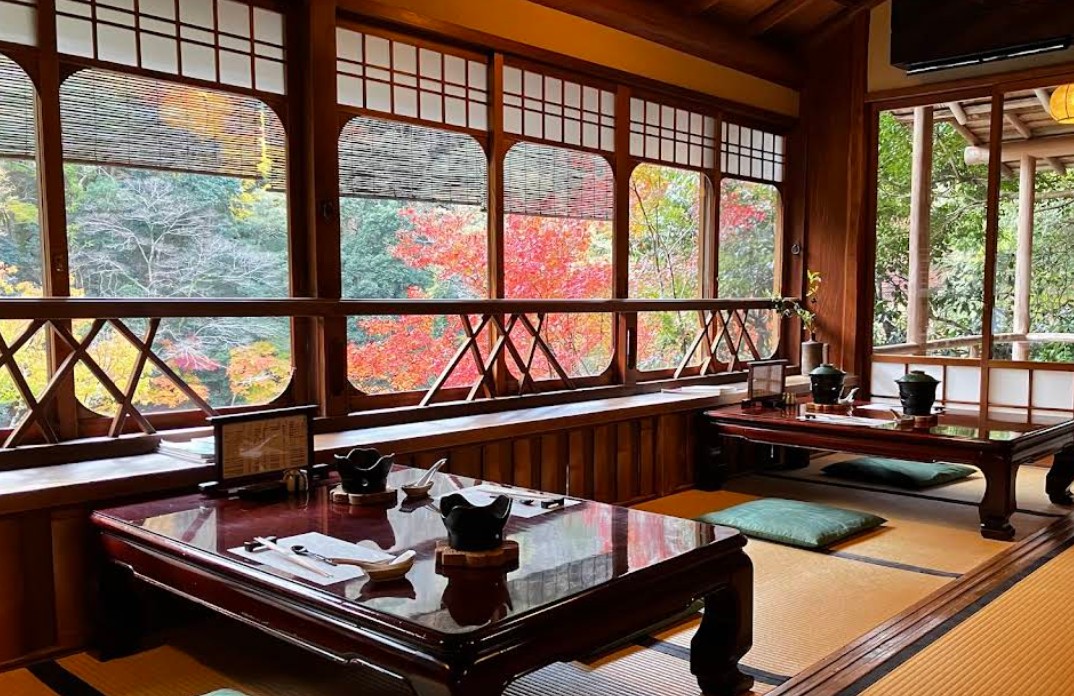
Shoraian (松籟庵)
Why it’s great: For something a little different, Shoraian specializes in tofu-based kaiseki meals. Located along the Katsura River in Arashiyama, it offers stunning views of the surrounding mountains and water. However, the most stunning thing is the price!
- Budget Tip: Lunch set menus start at around ¥4,500 to ¥7,000, making this one of the most affordable kaiseki-style experiences in Kyoto. Dinner prices are a bit more expensive but still extremely affordable, starting at ¥7,500 to ¥10,000.
- Atmosphere: This tofu kaiseki restaurant is situated at the foot of the beautiful Katsura River in Arashiyama. Enjoy the peaceful riverside dining and surrounding nature. It is especially beautiful in autumn when the leaves change color.
- Location: Arashiyama, near the famous Togetsukyo Bridge and bamboo grove.
- Reservations: Required. Please call via the number on their website here. (Have your hotel receptionist make the call if you would rather not talk on the phone, they would be happy to book for you.)
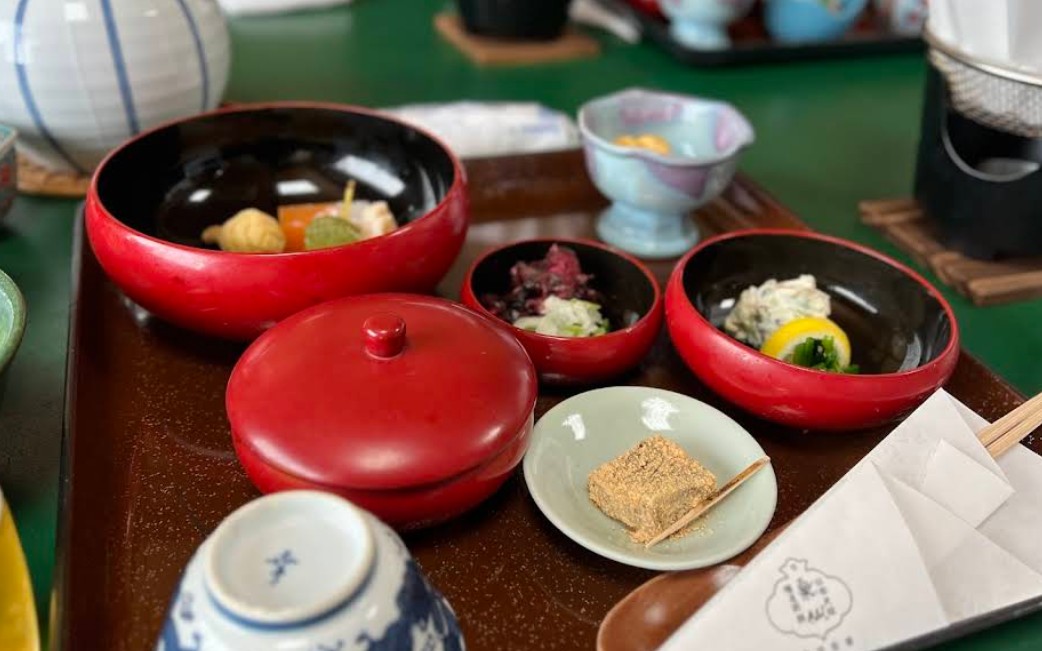
Izusen (泉仙)
Why it’s great: Izusen is located inside the Daitoku-ji Temple complex and specializes in shojin ryori, which is a traditional Buddhist vegetarian cuisine that shares many elements with kaiseki. It’s a serene, spiritual dining experience that highlights seasonal vegetables and tofu. This is the perfect place for vegetarians who want to experience kaiseki dining!
- Budget Tip: The shojin ryori kaiseki sets start at just ¥3,800, making it the most affordable option on our list. If you want to go all out, their most expensive set is ¥6,200, which is still an absolute steal for the amount of food and quality!
- Atmosphere: Their main restaurant is located next to a quiet temple. This creates a dining atmosphere that feels worlds away from the bustle of central Kyoto.
- Location: Next to Daitoku-ji Temple in northern Kyoto. This is the ideal location if you’re exploring Zen gardens and historic temples! There are many quiet and peaceful temples to explore here.
- Reservations: Reservations are recommended. Please make a reservation via their phone number listed on their website HERE. (Have your hotel receptionist make the call if you would rather not talk on the phone, they would be happy to book for you.)
Visit this vegetarian kaiseki restaurant HERE!
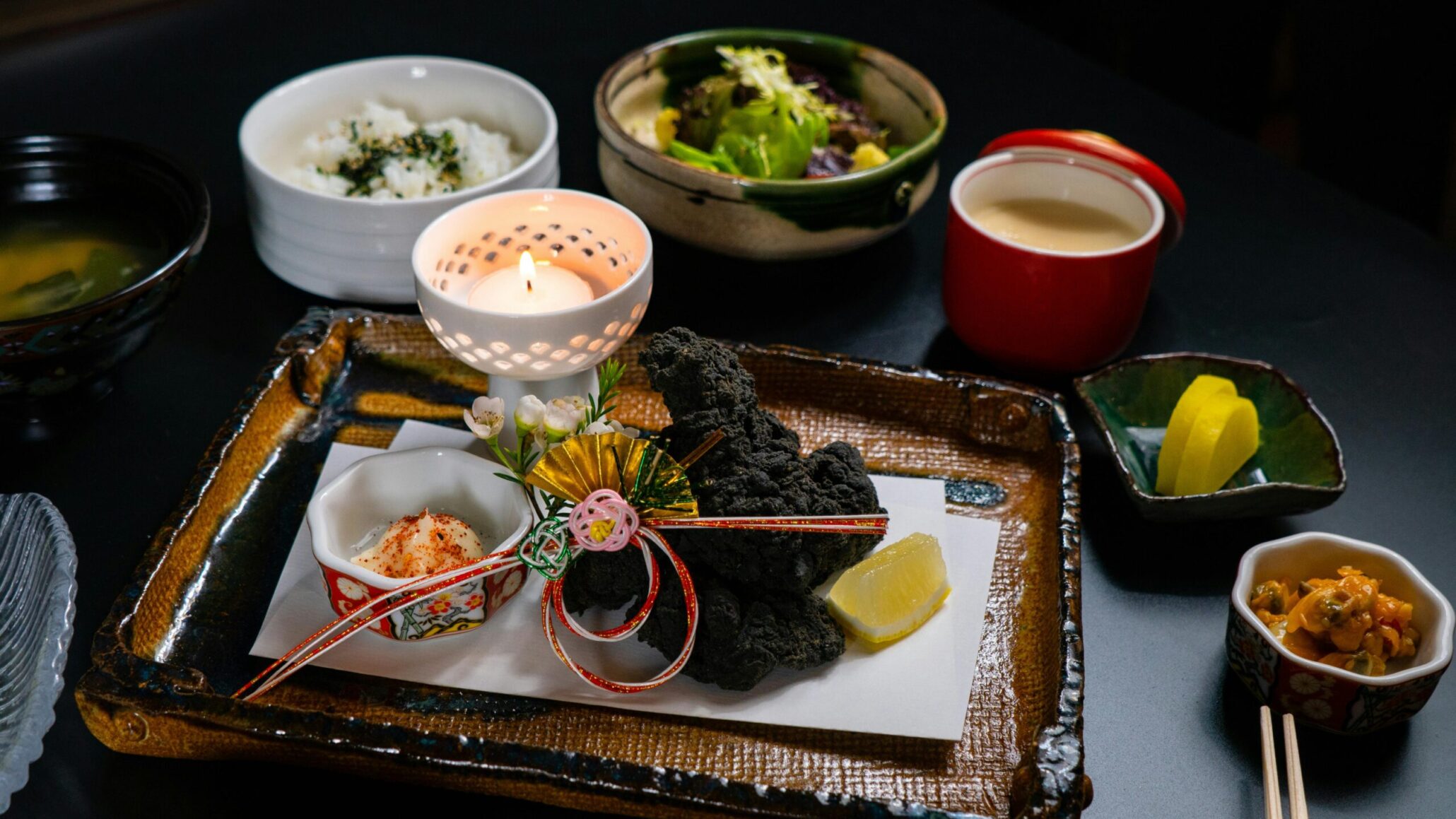
Kaiseki is often thought of as a once-in-a-lifetime luxury, but in Kyoto, you don’t have to spend a fortune to enjoy it. From temple-side vegetarian cuisine at Izusen to tofu-focused riverside dining at Shoraian, and from the historic elegance of Kinobu to the modern refinement of Roan Kikunoi, Kyoto offers countless ways to taste its culinary soul without breaking your budget.
If you’re visiting Kyoto, treat yourself to one of these five restaurants. You’ll not only enjoy Japan’s finest cuisine, but also experience the culture, artistry, and hospitality that make kaiseki so unique.

Interested in learning about incredible sightseeing locations across Kyoto? Make sure to check out our other blog posts, such as our guide to the Nishiki Market, the history of Fushimi Inari, and an itinerary for 3 full days in Kyoto.
We also run food tours in Kyoto, Tokyo, and Osaka, so be sure to put those on your itinerary when you come to Japan!
Speaking of itinerary, we at Ninja Food Tours provide itinerary reviews exclusively for our food tour guests. We also share personalized recommendations tailored to your trip! So be sure to check out our food tours in Kyoto!
Kaiseki in Kyoto FAQ
Q: Is kaiseki always expensive?
A: Not at all. While luxury restaurants exist, many places in Kyoto offer affordable lunch courses or budget-friendly tasting menus starting around ¥4,000–¥8,000.
Q: What’s the cheapest way to try kaiseki in Kyoto?
A: Opt for lunch courses, temple cuisine like Izusen, or tofu-based menus at places like Shoraian.
Q: Do I need to reserve in advance?
A: Yes. Even budget-friendly kaiseki restaurants book up quickly, especially in peak seasons (spring and autumn).
Q: Can vegetarians enjoy kaiseki?
A: Absolutely. Shojin ryori (Buddhist vegetarian cuisine) is a plant-based form of kaiseki that emphasizes vegetables, tofu, and seasonal produce.
Q: How long does a kaiseki meal take?
A: Expect anywhere from 1.5 to 3 hours, depending on the number of courses.
Q: Is kaiseki worth it?
A: Yes. It’s not just about the food — it’s about culture, art, and tradition. Even at budget-friendly spots, it’s an unforgettable experience.
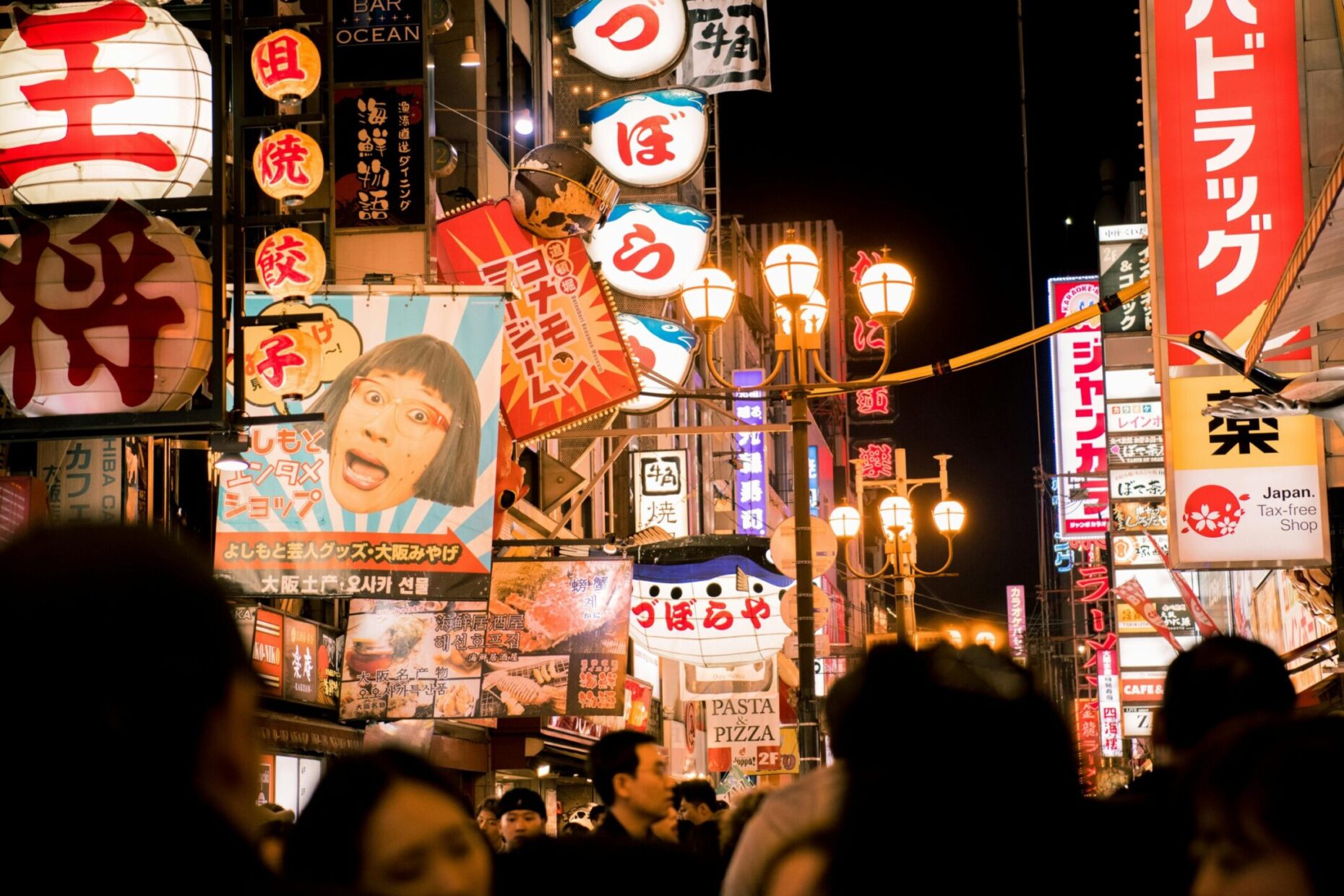
Seven of the Best Osaka Food Tours Worth Booking
Osaka is Japan’s unofficial food capital, a city where eating is casual, constant, and deeply local. Nicknamed the “eat-until-you-drop” city, Osaka is famous for takoyaki stands on street corners, sizzling okonomiyaki grills, late-night izakayas, and markets packed with vendors shouting daily specials. The energy is fun, but it can also be intimidating, especially when menus […]
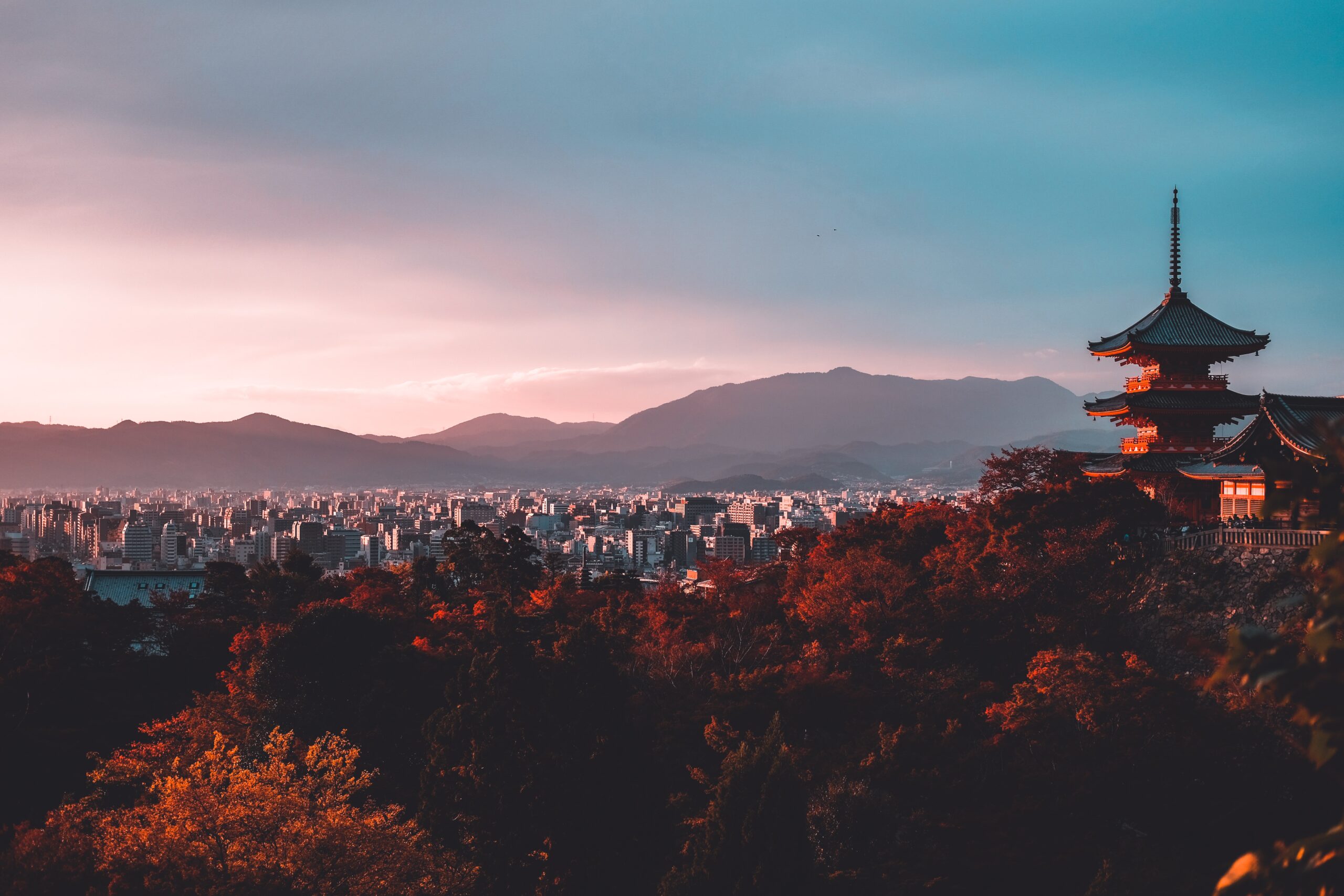
Five of the Best Kyoto Food Tour Companies (+ Sake Tour) You’ll Love, With Prices & What to Expect
Kyoto is Japan’s cultural heart and one of its most fascinating food cities. From centuries-old kaiseki traditions and tofu cuisine to matcha sweets and tiny izakayas tucked into back alleys, it can feel both beautiful and intimidating, especially if you don’t speak Japanese or know where to start. That’s where Kyoto food tours […]
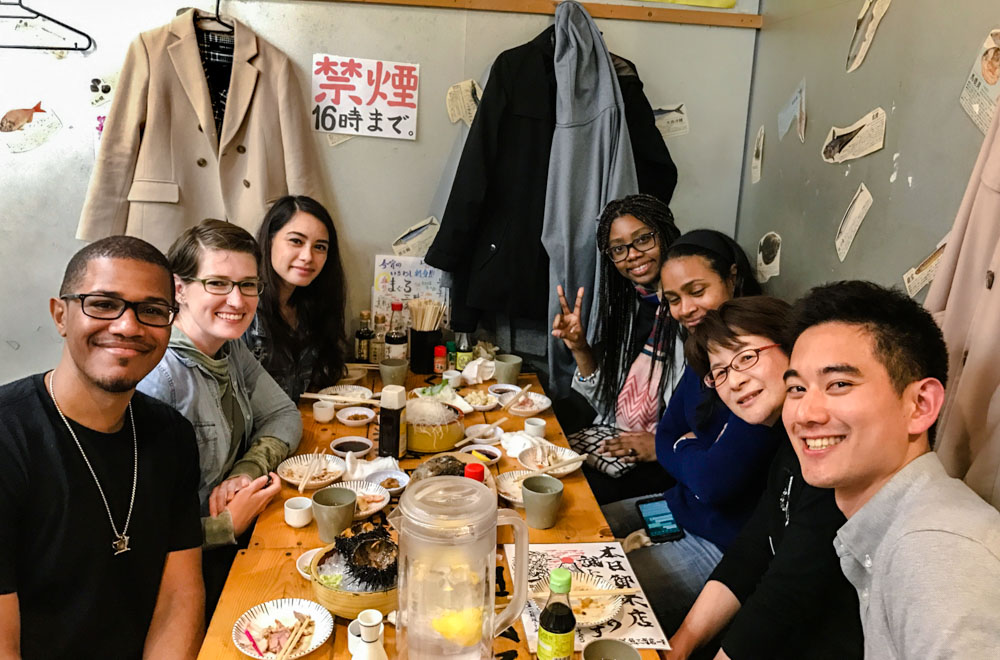
7 of the Best Tokyo Food Tour Companies You’ll Love (With Prices & What to Expect)
Tokyo can feel overwhelming for food lovers. The city has more than 160,000 restaurants, from tiny ramen counters to lantern-lit izakayas and Michelin-starred sushi bars. It’s magical, but also intimidating if you don’t speak Japanese or know where to begin. That’s where food tours shine: they cut through the chaos and connect travelers with authentic local […]

Where to Get the Best Coffee in Kyoto: Local Favorites and Hidden Gems
Kyoto may be famous for its temples, tea ceremonies, and timeless streets, but locals know this city runs just as much on coffee as it does on matcha. Tucked between quiet lanes and bustling markets, you’ll find an ever-growing scene of cafés that blend Japanese craftsmanship with global coffee culture. From minimalist roasters pouring single-origin […]

